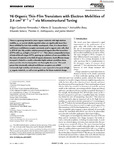Y6 Organic Thin-Film Transistors with Electron Mobilities of 2.4 cm² V⁻¹ s⁻¹ via Microstructural Tuning

Use este enlace para citar
http://hdl.handle.net/2183/29996
A non ser que se indique outra cousa, a licenza do ítem descríbese como Attribution 4.0 International (CC BY 4.0)
Coleccións
- GI-Polímeros - Artigos [32]
- OpenAIRE [357]
Metadatos
Mostrar o rexistro completo do ítemTítulo
Y6 Organic Thin-Film Transistors with Electron Mobilities of 2.4 cm² V⁻¹ s⁻¹ via Microstructural TuningAutor(es)
Data
2022-01-05Cita bibliográfica
Gutierrez-Fernandez, E., Scaccabarozzi, A. D., Basu, A., Solano, E., Anthopoulos, T. D., Martín, J., Y6 Organic Thin-Film Transistors with Electron Mobilities of 2.4 cm² V⁻¹ s⁻¹ via Microstructural Tuning. Adv. Sci. 2022, 9, 2104977. https://doi.org/10.1002/advs.202104977
Resumo
[Abstract] There is a growing demand to attain organic materials with high electron mobility, μe, as current reliable reported values are significantly lower than those exhibited by their hole mobility counterparts. Here, it is shown that a well-known nonfullerene-acceptor commonly used in organic solar cells, that is, BTP-4F (aka Y6), enables solution-processed organic thin-film transistors (OTFT) with a μe as high as 2.4 cm² V⁻¹ s⁻¹. This value is comparable to those of state-of-the-art n-type OTFTs, opening up a plethora of new possibilities for this class of materials in the field of organic electronics. Such efficient charge transport is linked to a readily achievable highly ordered crystalline phase, whose peculiar structural properties are thoroughly discussed. This work proves that structurally ordered nonfullerene acceptors can exhibit intrinsically high mobility and introduces a new approach in the quest of high μe organic materials, as well as new guidelines for future materials design.
Palabras chave
Electron mobility
Nonfullerene acceptors
Organic thin-film transistors
Polymorphism
Nonfullerene acceptors
Organic thin-film transistors
Polymorphism
Descrición
Financiado para publicación en acceso aberto: Universidade da Coruña/CISUG
Versión do editor
Dereitos
Attribution 4.0 International (CC BY 4.0)
ISSN
2198-3844






